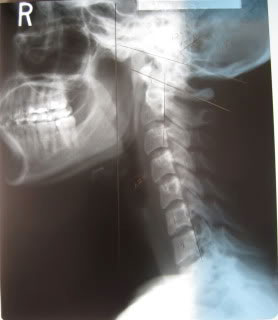The Straight Neck in Fibromyalgia
The Straight Neck in Fibromyalgia
Presented by Robert S. Katz, MD
 Conditions related to the cervical spine continue to be of interest in the definition and treatment of fibromyalgia (FM). Several papers have been published regarding cervical stenosis (compression of the spinal cord in the neck), including a recent publication in the Pain Management journal about positional cervical cord compression and the correct MRI to diagnose the condition in FM patients. Another area of interest has to do with a straight neck phenomenon that in its-self can cause cervical cord compression and disability. The following article is meant as an educational piece concerning an ACR poster which offers more evidence of cervical neck compromise in a large cohort of FM patients.
Conditions related to the cervical spine continue to be of interest in the definition and treatment of fibromyalgia (FM). Several papers have been published regarding cervical stenosis (compression of the spinal cord in the neck), including a recent publication in the Pain Management journal about positional cervical cord compression and the correct MRI to diagnose the condition in FM patients. Another area of interest has to do with a straight neck phenomenon that in its-self can cause cervical cord compression and disability. The following article is meant as an educational piece concerning an ACR poster which offers more evidence of cervical neck compromise in a large cohort of FM patients. The purpose of this study was to ascertain cervical spine abnormalities in FM patients. According to Dr. Katz, lordosis, or the natural curve of the neck, is missing in most FM patients. The straight neck in FM patients was based on calculating the Cobb angle, a standard radiographic measurement of lateral view x-rays of the cervical spine (C-1 through C-7).
The lordotic curve of cervical spine x-rays was measured by analyzing the Cobb angle in 138 consecutive patients in a rheumatology office practice. All the patients met the ACR criteria for FM and complained of moderate to severe neck pain. 23 additional patients with FM followed in the same medical practice had cervical radiographs reviewed visually by both a rheumatologist and an X-ray technician, but did not also have the Cobb angle measured (visual inspection group). The amount visual curvature was noted by each as 1 (straight neck), 2 slight lordotic curve) and3 (normal lordotic curve).
98 of 138 (71%) of the FM patients had a straight spine (Cobb angle less than 14 degrees). 24 of 138 (17%) of the FM patients had a small lordotic curve of the lateral view of the cervical spine x-rays (Cobb angle 14-18 degrees). 16 of 138 (12%) of the patients had a normal Cobb angle (more that 18 degrees) and a normal lordotic curve.
20 (87%) of 23 additional FM patients (visual inspection group) had a straight cervical spine by visual inspection. They had lost the normal lordotic curve. 3 (13%) of the FM patients had a slightly curved cervical spine. No FM patient had a normal cervical lordosis by visual inspection of lateral views of radiographs of the cervical spine. The Cobb angle in 10 rheumatic disease controls was 22.5 degrees and reported to be 26.8 degrees in healthy controls.
In conclusion, 88% of the FM patients in this study had a straight neck based on measuring the Cobb angle, and 90% had a straight neck by visualizing the lateral view of cervical spine x-rays. The cause of the straight cervical spine in FM is unknown. Speculation of the pathophysiology includes chronic muscle contraction and tightness of other soft tissues.
A straight cervical spine in the absence of other radiological abnormalities might assist in the diagnosis of fibromyalgia, and it may be important in attempting to understand the pathophysiology of this disorder.
Click here to read the abstract in its entirety





